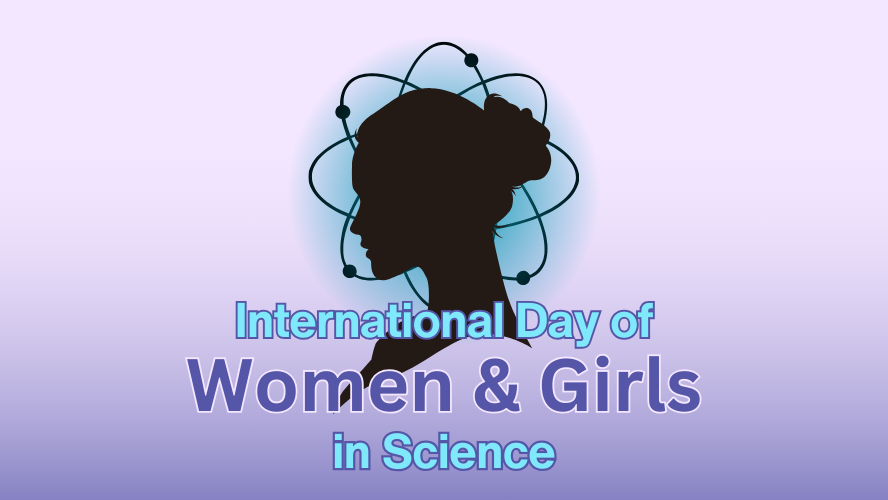
On February 11, we celebrate the International Day of Women and Girls in Science—a day dedicated to recognizing the extraordinary contributions of women across UHN who are advancing discovery and shaping the future of health care innovation. From game-changing researchers to dedicated postdocs, technicians, and staff, women at UHN play a critical role in driving scientific progress and fostering A Healthier World.
This year, UHN Women took a bold step in addressing gender representation in science by organizing a Wikipedia Edit-a-Thon as part of TAHSN’s Moving the Needle event. With only 20% of Wikipedia biographies dedicated to women, this initiative aimed to bridge the visibility gap by creating and updating pages that highlight the achievements of women in STEM. Thanks to our incredible volunteers, we added 20 new Wikipedia pages, ensuring that the legacies of accomplished women scientists are documented and accessible to all.
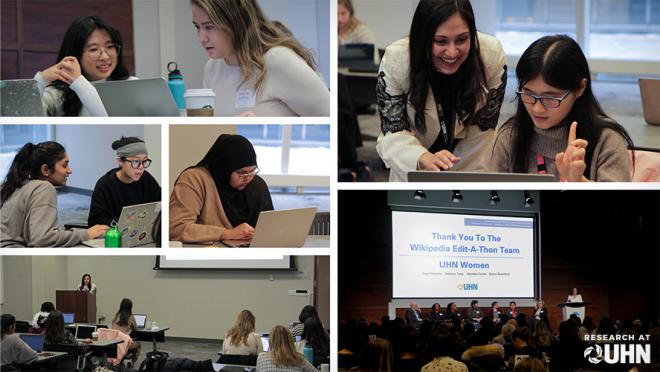
Highlights from our Wikipedia Edit-a-Thon: Thanks to our dedicated volunteers, we created and updated 20 pages, ensuring more women in science receive the recognition they deserve.
In addition to this impactful initiative, we are proud to feature the inspiring stories of six remarkable individuals—postdocs, technicians, and researchers—who are driving discovery and innovation at UHN. Their dedication, resilience, and impactful work are shaping the future of science and health care.
Join us in honouring TeamUHN's incredible women who are making an indelible mark in science.
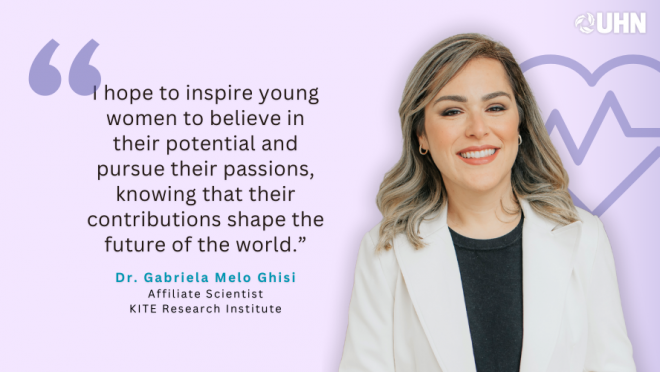
Dr. Gabriela Melo Ghisi, Affiliate Scientist at the KITE Research Institute
Research Area:
Cardiovascular disease prevention and rehabilitation
Favourite Science Fun Fact:
The human heart beats about 100,000 times a day, pumping nearly 2,000 gallons of blood – and women’s hearts beat faster than men’s!
Who or what inspired you to pursue a career in science?
Growing up in Brazil, I saw firsthand the profound impact of cardiovascular diseases on underserved communities. Today, many of my patients face significant barriers to health care access. Their challenges deeply fuel my passion to bridge these gaps and bring better care to those who need it most.
What aspect of your work excites you the most and how does your work help advance UHN's vision of A Healthier World?
The most exciting part of my work is the opportunity to develop and implement innovative patient education strategies that empower individuals to take control of their heart health. When we give people the proper tools to manage their own health—through education and resources—we help build a healthier, more resilient society.
What does it mean for you to be a woman in science?
Being a woman in science means embracing my identity to break barriers, pave the way for future generations, and contribute diverse perspectives to research. It also means advocating for gender equity in health care and research leadership and overcoming cultural and systemic challenges to create meaningful change in science and society.
How can we collectively create a more inclusive and supportive environment for women and girls in science?
We can foster inclusivity by promoting mentorship programs, ensuring equal opportunities for leadership roles, and challenging gender biases in scientific research and funding. Encouraging work-life balance and visibility of female role models in science is also crucial.
How do you see your role in inspiring the next generation of girls interested in STEM fields?
As a woman, mother, and immigrant from a low- and middle-income country, I’ve defied the odds to become a global leader in cardiovascular rehabilitation. My journey shows young women that despite challenges, they can rise and lead in any field. By sharing my story, I hope to inspire young women to believe in their potential and pursue their passions, knowing that their contributions shape the future of the world.
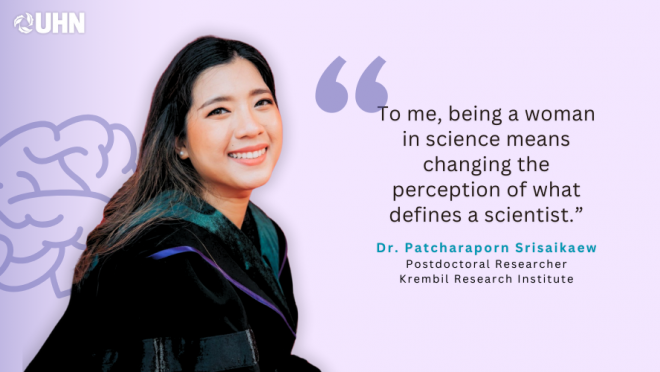
Dr. Patcharaporn Srisaikaew, Postdoctoral Researcher at the Krembil Research Institute
Research Area:
Neuroscience, aging, chronic neuropathic pain, and limbic structures
Favourite Science Fun Fact:
The brain is one of the hungriest organs in the body, consuming about 20% of our daily energy while making up only 2% of our body weight! Fascinating!
Who or what inspired you to pursue a career in science?
I am deeply driven by the potential impact scientific research can have on patient care. The knowledge that my work could improve treatments and help manage health conditions is a powerful motivator. It’s incredibly rewarding to be part of the STEM field, where research and innovation can enhance the quality of life for individuals struggling with chronic health issues. My passion lies in health care, science, and informatics, with a particular focus on advancing the well-being of older adults. I find it inspiring to contribute to a field that directly influences patient care and supports healthier, more fulfilling lives.
What aspect of your work excites you the most and how does your work help advance UHN's vision of A Healthier World?
What excites me most about UHN is the constant opportunity to learn and solve complex problems. Every day presents new challenges, and it's fulfilling to engage with cutting-edge science. My postdoctoral work aims to help patients with trigeminal neuralgia, a debilitating pain condition, by uncovering brain abnormalities linked to cognitive function in aging and chronic pain. These insights could lead to better detection and personalized treatments, aligning with UHN's vision of creating A Healthier World.
What does it mean for you to be a woman in science?
To me, being a woman in science means changing the perception of what defines a scientist. It signifies that we are empowered women who recognize our self-worth. We have proven that women can also make significant contributions to research and innovation in STEM. I take pride in embracing both my scientific identity and my individuality. I can be kind, cheerful, and lively while still being a fun and capable scientist in STEM—proving that one can be passionate, dynamic, and impactful in STEM.
How can we collectively create a more inclusive and supportive environment for women and girls in science?
We, as women and girls in science, often encounter gender-specific barriers and challenges in our careers and professional development. I would like to take this opportunity to emphasize that fostering inclusivity and a supportive environment for women and girls in science requires us to actively support, mentor, and uplift one another. By encouraging each other and allowing everyone to learn through supportive partners and communities, we can empower ourselves. It is essential to create a safe and welcoming environment for all women and girls in STEM, ensuring equitable opportunities and promoting recognition of women in the field, which are critical steps toward meaningful progress. The International Day of Women and Girls in Science offers an important platform to celebrate achievements and drive future advancements for women and girls in the field.
How do you see your role in inspiring the next generation of girls interested in STEM fields?
I am committed to mentoring and outreach. I volunteer at UHN STEM Pathways, serve on the Outreach and Communication Committee at UHN’s Research Inclusion, Diversity, Equity, and Accessibility (IDEA), and am a member of the Krembil Trainee Affairs Committee. Additionally, I am the Career Development & Mentoring Manager for the OHBM Students and Postdocs Special Interest Group. I aim to create opportunities for aspiring students and trainees worldwide. I believe in the power of support and empowerment. I encourage the next generation of girls in STEM to embrace challenges, learn from setbacks, and keep moving forward. Together, we can redefine what’s possible. I look forward to becoming a leader who inspires future generations.
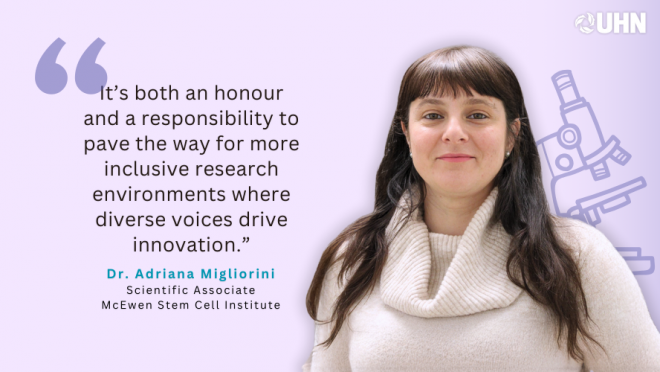
Dr. Adriana Migliorini, Scientific Associate at the McEwen Stem Cell Institute
Research Area:
Using human pluripotent stem cells to generate insulin-producing cells and investigating their interactions with immune cells—particularly macrophages—to advance cell replacement therapies for diabetes.
Favourite Science Fun Fact:
The name “macrophage” comes from a Greek word meaning “big eater,” highlighting their key role in engulfing and destroying foreign particles and dead cells through phagocytosis.
Who or what inspired you to pursue a career in science?
I was inspired by early mentors and my innate curiosity about how the world works, which revealed to me the transformative power of science. Their encouragement, along with the potential for meaningful impact, has driven me to pursue a career where every discovery matters. Moreover, witnessing how science can transform the treatment of chronic diseases like diabetes continues to motivate me to push the boundaries of stem cell research.
What aspect of your work excites you the most and how does your work help advance UHN's vision of A Healthier World?
I’m most excited by the challenge of translating fundamental discoveries in stem cell biology into innovative, clinical therapies for Type 1 Diabetes. I hope my work contributes to A Healthier World by striving to develop effective cell replacement strategies that could dramatically improve the quality of life for patients living with diabetes.
What does it mean for you to be a woman in science?
Being a woman in science means contributing a unique perspective that challenges traditional boundaries and enriches the field with creativity and resilience. It’s both an honour and a responsibility to pave the way for more inclusive research environments where diverse voices drive innovation.
How can we collectively create a more inclusive and supportive environment for women and girls in science?
We can foster inclusivity by promoting mentorship opportunities, celebrating diverse achievements, and ensuring equitable access to resources and leadership roles in STEM. Building strong networks of support and encouraging open dialogue can empower more women and girls to pursue their scientific passions.
How do you see your role in inspiring the next generation of girls interested in STEM fields?
I see myself as both a mentor and a role model, eager to share my journey and the challenges I’ve overcome to demonstrate that perseverance and passion can lead to exciting scientific discoveries. Through active engagement in outreach initiatives—such as serving as a STEM pathway Ambassador for the McEwen Stem Cell Institute—I strive to empower the next generation of young women scientists to dream big and innovate boldly.
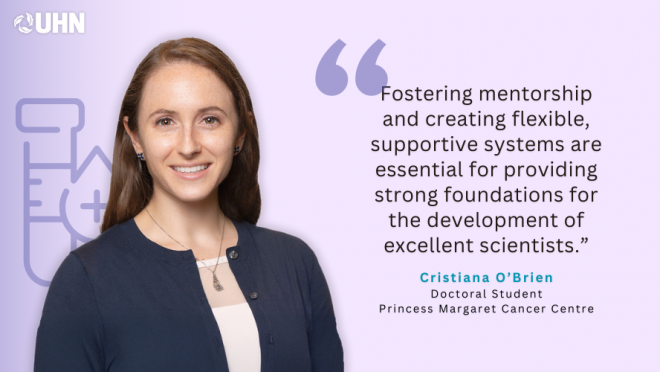
Cristiana O’Brien, Doctoral Student at the Princess Margaret Cancer Centre
Research Area:
Acute myeloid leukemia metabolism
Favourite Science Fun Fact:
Lipids in avocados have anti-leukemia effects.
Who or what inspired you to pursue a career in science?
During a high school field trip, I visited a conservation area where we collected water samples and observed them under a microscope. Seeing an entire ecosystem in just a few drops of water made me realize the incredible potential of microscopy. That moment sparked my interest in science and set me on the path to where I am today.
What aspect of your work excites you the most and how does your work help advance UHN's vision of A Healthier World?
The advantage of working at a remarkable place like Princess Margaret, is getting to collaborate with different teams such as the leukemia biobank which is working to improve the prevention, diagnosis, and treatment of blood disorders by aiding research on these diseases. I am grateful to be involved in research that can contribute to a deeper understanding of acute myeloid leukemia and improve patient outcomes.
What does it mean for you to be a woman in science?
It is important for me to give back to the community through outreach, support, and celebrating peers, while also demonstrating resilience in navigating my own challenges.
How can we collectively create a more inclusive and supportive environment for women and girls in science?
In my experience, fostering mentorship and creating flexible, supportive systems are essential for providing strong foundations for the development of excellent scientists.
How do you see your role in inspiring the next generation of girls interested in STEM fields?
I would be honoured if I could inspire the same enthusiasm for science that I felt when I first looked through a microscope. Through outreach and sharing my research, I hope to spark excitement and encourage young scientists to explore opportunities in STEM.
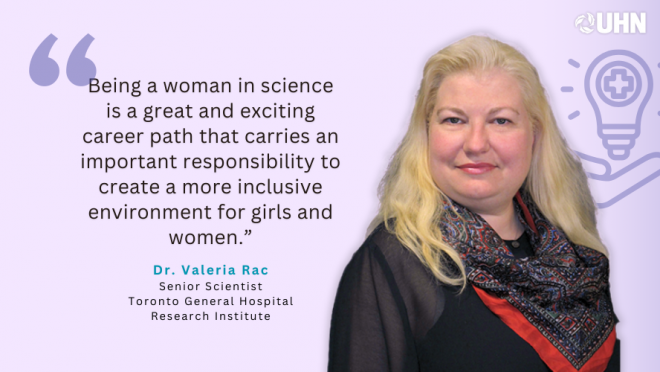
Dr. Valeria Rac, Senior Scientist at the Toronto General Hospital Research Institute
Research Area:
Health Technology Assessment, Health Services and Policy Research
Favourite Science Fun Fact:
Marya Salomee Sklodowska Curie (my favourite scientist), was the first woman hired as a professor at the Sorbonne University in 1906. She was the first person and the only woman to win two Nobel Prizes (physics and chemistry), and she named an element ‘polonium’ after her native country, Poland.
Who or what inspired you to pursue a career in science?
My dad inspired me to pursue a career in science and medicine. He was a doctor of veterinary medicine and a PhD-trained scientist. When I was four years old, he used to take me to his lab at the University of Sarajevo Veterinary School every Sunday. One time, my dad let me look under the microscope, and that’s when the magic started. Every Sunday afterwards, I would eagerly get ready to go to ‘work’ with my dad to look under the microscope. I even attended my dad’s PhD defence—I was eight. My dad used to read every single paper that I wrote and would discuss my research ideas; he was my sounding board. He inspired my curiosity as a young child and instilled in me the importance of integrity, transparency, and credibility in science and research.
What aspect of your work excites you the most and how does your work help advance UHN's vision of A Healthier World?
Being a scientist is a great privilege, and I consider myself extremely lucky that I get to do it. I get to work with a fantastic team to create new ideas and research methods for complex problems in the health care system. The most exciting part is working with people with lived experience and feeling their enthusiasm to help make things better. We work and collaborate with highly underserved patient populations and communities, and improving their care and health is the most rewarding experience.
What does it mean for you to be a woman in science?
Being a woman in science is a great and exciting career path that carries an important responsibility to create a more inclusive environment for girls and women. It means supporting other women, opening the doors for them, and creating opportunities for their leadership. We still have a long way to go. I have been blessed to work with some great women scientists and clinicians in my career who have been great mentors and sponsors, such as Drs. Cathy Whiteside, Heather Ross, and Audrey Laporte to name a few. I hope to pay it forward for the next generations.
How can we collectively create a more inclusive and supportive environment for women and girls in science?
Although some initiatives have been implemented to create a more inclusive environment, it is still challenging for women in science, particularly women and girls of colour, who face complex barriers. A multipronged approach is needed, involving the community, educational institutions, and society. Engaging girls in science at younger ages and creating opportunities for exploration is a good start. For women already in science, we must offer growth and leadership opportunities, address biases, and ensure meaningful representation in leadership roles. While some initiatives are promising, many institutions are still talking the talk without truly following through—and that must change.
How do you see your role in inspiring the next generation of girls interested in STEM fields?
I plan to continue inspiring the next generation of girls interested in STEM fields to believe in themselves and their abilities in order to build their confidence and passion to pursue these interests. Having women’s representation in STEM fields is extremely important for creating a more inclusive environment that will disrupt outdated societal biases and stereotypes. I hope that by seeing me and other women in STEM fields, the next generation will be encouraged to build their careers in STEM. By creating a strong network and a nurturing environment, we can provide support, mentorship, and a sense of belonging to the next generations of women and girls.
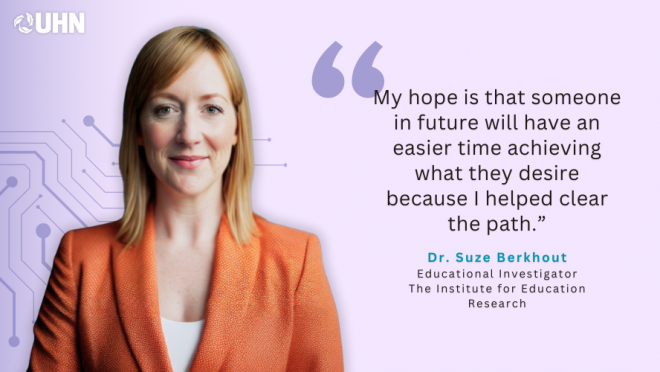
Dr. Suze Berkhout, Educational Investigator at The Institute for Education Research
Research Area:
Feminist science and technology studies
Favourite Science Fun Fact:
Female orcas go through menopause and orcas experience something called the "grandmother effect" where the offspring of families with grandmothers live longer. Scientists think this is because of the elder orcas’ knowledge of hunting and how they help to provide for their younger kin.
Who or what inspired you to pursue a career in science?
I am inspired by many of the untold stories of women in science whose profound influences we may not recognize. Some of these women include Rosalind Franklin, Katherine Johnson, Barbara McClintock, and Ursula Franklin. In particular, Ursula Franklin was the first woman to be nominated to the level of University Professor at the University of Toronto.
What aspect of your work excites you the most and how does your work help advance UHN’s vision of A Healthier World?
Experimenting with new methodologies is the most creative and exciting part of my research. My work helps us think carefully and critically about the impact of medicine and science. It invites people to understand how to be more collaborative in science and research so that more people can participate and receive the benefits of innovation.
What does it mean for you to be a woman in science?
Being a woman in science means bringing who I am and where I come from to my work. It is also about helping expand the voices and contributors to science and understanding that science is a creative and collaborative process.
How can we collectively create a more inclusive and supportive environment for women and girls in science?
If it weren't for the women who came before me, planting seeds, I wouldn't be where I am today. Those ahead must nurture the passions of future generations and create opportunities for them to act on their ideas. Additionally, we must ensure that institutions provide support for those lacking financial or emotional resources, so that individuals who may not see themselves in science and medicine are not excluded.
How do you see your role in inspiring the next generation of girls interested in STEM fields?
I am fortunate to be in a position where I can try new things that may not work and bring ideas, fields, and approaches together that have never been in conversation with one another. My hope is that someone in future will have an easier time achieving what they desire to do because I helped to clear the path.




